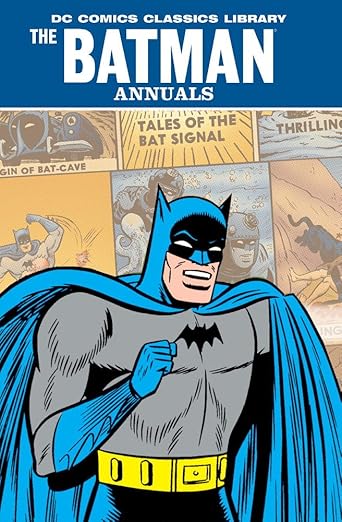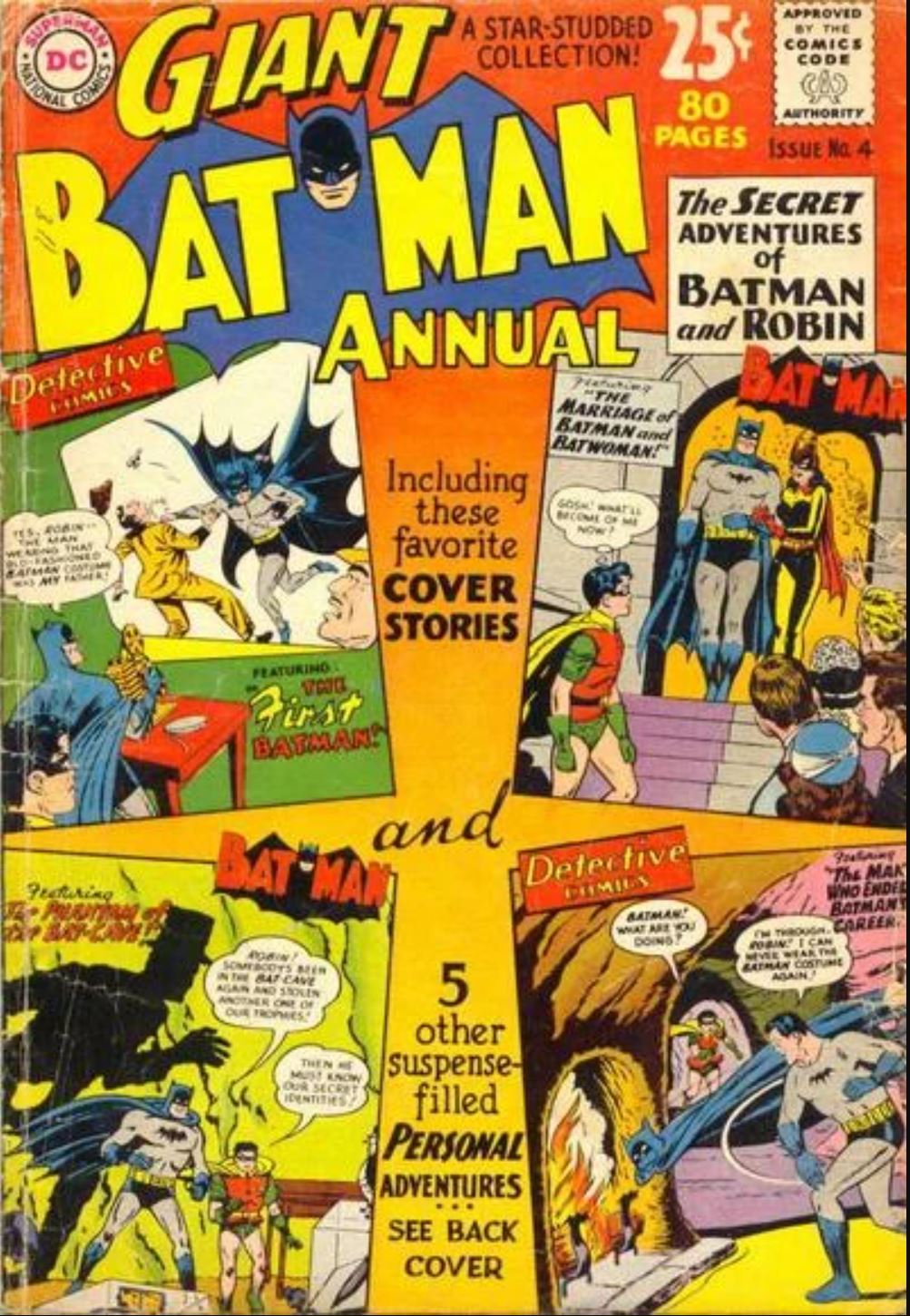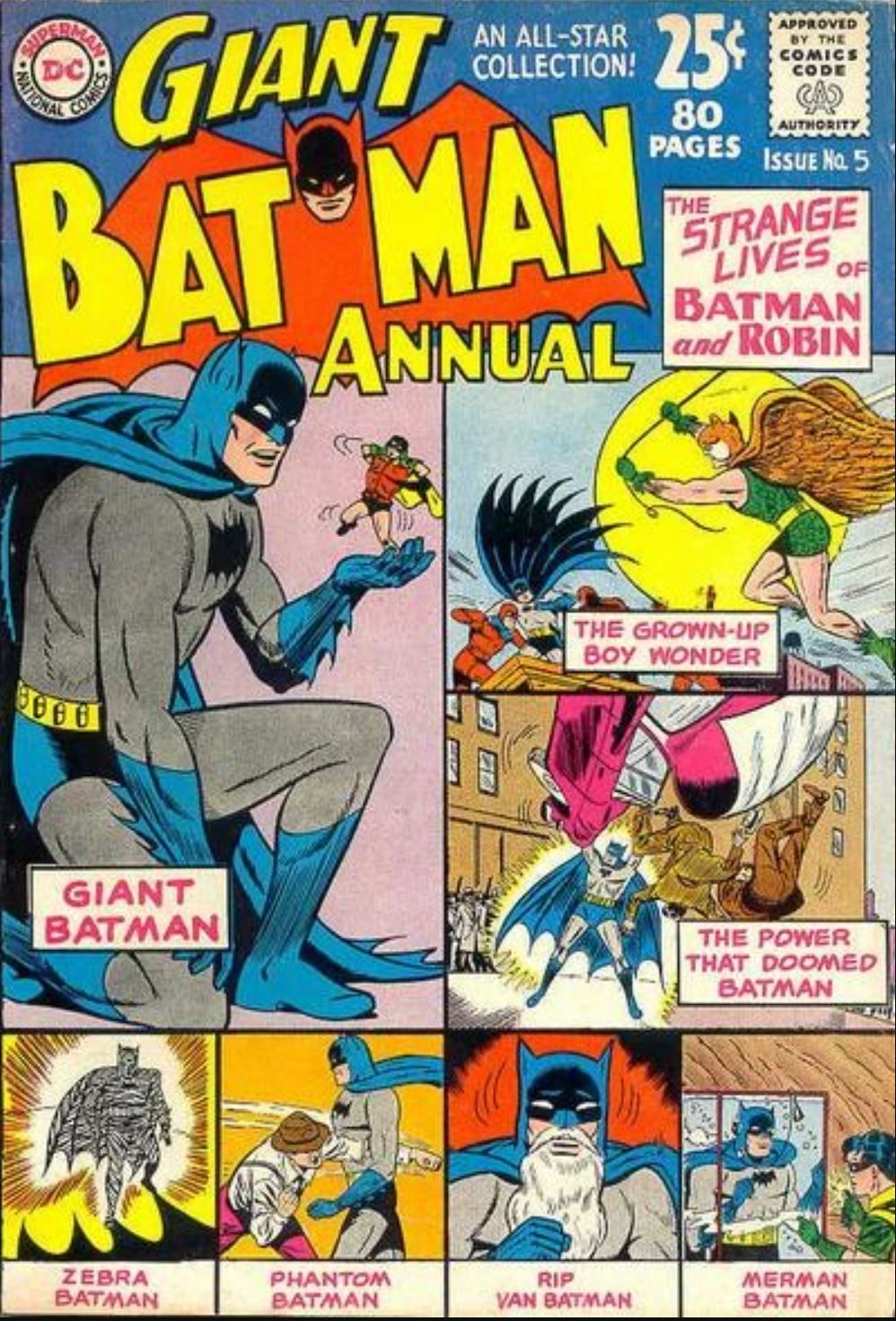


By Bob Kane, Bill Finger, Win Mortimer, Jim Mooney, Curt Swan, Jack Burnley, Sheldon Moldoff, Charles Paris, John Fischetti, John Giunta, Fred Ray, Don Cameron, David Vern Reed, Jack Schiff & various (DC Comics)
ISBN: 978-1-4012-0415-0 (HB/vol 1) 978-1-4012-2625-1 (HB/vol 2)
These books include Discriminatory Content produced in less enlightened times.
Robin the Boy Wonder debuted in Detective Comics #38, cover-dated April 1940 and on sale from March 6th of that momentous year. He was created by Bob Kane, Bill Finger & Jerry Robinson, introducing a juvenile circus acrobat whose parents were murdered by a mob boss. The story of how Batman took the orphaned Dick Grayson under his scalloped wing and trained him to fight crime has been told, retold and revised many times over the decades (some of which we’ll revisit over the next 12 months) and still regularly undergoes tweaking to this day.
In chronological DC comics continuity Grayson fought beside Batman until 1970 when, as an indicator of those turbulent times, he flew the nest, becoming a Teen Wonder college student and ultimately leader of a team of fellow sidekicks and young justice seekers: the Teen Titans. He graduated to his own featured solo spot in the back of Detective Comics from the end of the 1960s, where he alternated and shared space with Batgirl, holding a similar spot throughout the 1970s in Batman, before winning a starring feature in the anthological Batman Family and Giant Detective Comics Dollar Comics. During the 1980s he led a New Teen Titans team, initially in his original costumed identity, but eventually reinvented himself as Nightwing, whilst (re)establishing a turbulent working relationship with his mentor Batman.
Robin’s groundbreaking creation as a junior hero for young readers to identify with inspired an incomprehensible number of costumed kid crusaders, and Grayson continues in similar innovative vein for the older, more worldly-wise readership of America’s increasingly rebellious contemporary youth cultures. However, his star potential was first realised much earlier in his halcyon career…
From 1947 to 1952 (and issues #65-130), Robin the Boy Wonder carried his own solo series – and regular cover spot – in Star Spangled Comics at a moment when the first superhero boom was fading and being replaced by traditional genres like crime, westerns, war and boys’ adventure stories. His exploits blended in-continuity action capers with more general youth-oriented fare, reducing adults Batman, Alfred and Commissioner Gordon to minor roles or indeed rendering them entirely absent, allowing the kid crusader to display not just his physical skills but also his brains, ingenuity and guts.
Long out of print and crying out for modern reissue in some form as well as completion of the full run, these stellar Archive compilations re-present the first 21 tales from Star Spangled #65-85 (covering February 1947 to October 1948) in volume 1 before adding the exploits from ASC #86-105 (November 1948-June 1950) as a second tome.
Compelling but uncomplicated, these yarns recapture the bold, verve and universal appeal of one of fantasy literature’s greatest youth icons, opening with volume 1’s fascinating Roy Thomas penned Foreword, discussing the origins and merits of boy heroes and history of the venerable anthology title before offering some insightful guesses as to the identity of the generally un-named writers of the Robin strip. Although almost universally unrecorded, most historians consider Batman co-creator Bill Finger to be author of most if not all of the stories and I’m going to happily concur here with that assessment until informed otherwise…
Star Spangled Comics #65 starts the ball rolling with ‘The Teen-Age Terrors’ illustrated by Win Mortimer (with the inking here misattributed to Charles Paris) in which the Caped Crusaders’ faithful butler happens across an unknown trophy and is regaled with Dick’s tale of that time when he infiltrated a Reform School to discover who inside was releasing the incarcerated kids to commit crimes on the outside…
That tale segues seamlessly into ‘The No-Face Crimes’ wherein the Boy Wonder acts as stand-in to a timid young movie star targeted by a ruthless killer, and #67 reveals ‘The Case of the Boy Wonders’ as our hero becomes part of a trio of boy geniuses kidnapped for the craziest of reasons. In #68 an outrageously flamboyant killing results in the pre-teen titan shipping out on a schooner as a cabin boy, spending ‘Four Days Before the Mast’ to catch a murderer, after which modern terror takes hold when Robin is the only one capable of tracking down ‘The Stolen Atom Bomb’ in a bombastically explosive contemporary spy thriller. Star Spangled Comics #70 then introduced an archvillain all his own for the junior crime crusher, as ‘Clocks of Doom’ premiered an anonymous criminal time-&-motion expert forced into the limelight once his face was caught on film. The Clock’s desperate attempts to sabotage the movie Robin is consulting on inevitably leads to hard time in this delightful romp (this one might possibly scripted by Don Cameron)…
Chronal explorer Professor Carter Nichols succumbs to persistent pressure and sends Dick Grayson back to the dawn of history in #71’s ‘Perils of the Stone Age’ – a deliciously anachronistic cavemen & dinosaurs epic with Robin kickstarting freedom and democracy, after which the Boy Wonder crashes the Batplane on a desert island, encountering a boatload of escaped Nazi submariners in ‘Robin Crusoe’ – a full-on thriller illustrated by Curt Swan & John Fischetti. In SSC #73 the so-very-tractable Professor Nichols dispatches Dick to revolutionary France where Robin battled Count Cagliostro, ‘The Black Magician’ in a stirring saga drawn by Jack Burnley & Jim Mooney, after which the Timepiece Terror busts out of jail set on revenge in ‘The Clock Strikes’ as illustrated in full by Mooney – who would soon become the series’ sole artist. Before that Bob Kane & Charles Paris step in to deliver a tense courtroom drama in #75 as ‘Dick Grayson for the Defense’ finds the millionaire’s ward fighting for the rights of a schoolboy unjustly accused of theft. Then cunning career criminal The Fence comes a cropper when trying to steal 25 free bikes given as prizes to Gotham’s city’s best students in ‘A Bicycle Built for Loot’ (Finger & Mooney).
Prodigy and richest kid on Earth, Bert Beem is sheer hell to buy gifts for, but since the lad dreams of being a detective, the offer of a large charitable donation secures the Boy Wonder’s cooperation in a little harmless role play. Sadly, when real bandits replace actors and Santa, ‘The Boy Who Wanted Robin for Christmas’ enjoys the impromptu adventure of a lifetime…
Another rich kid is equally inspired in #78, becoming the Boy Wonder of India, but soon needs the original’s aid when a Thuggee murder-cult decides to destroy ‘Rajah Robin’, after which ‘Zero Hour’ (illustrated by Mooney & John Giunta) sees The Clock strike again with a spate of regularly-scheduled time crimes before Star Spangled #80 reveals Dick Grayson as ‘The Boy Disc Jockey’, only to discover the station is broadcasting coded instructions to commit robberies in its cryptically cunning commercials. Robin is temporarily blinded in #81 whilst investigating the bizarre theft of guide dogs, but quickly adapts to his own canine companion and solves the mystery of ‘The Seeing-Eye Dog Crimes’, but has a far tougher time as a camp counsellor for ghetto kids after meeting ‘The Boy Who Hated Robin’. It takes grit, determination and a couple of escaped convicts before the kids learn to adapt and accept…
A radio contest leads to danger and death before one smart lad earns the prize for discovering who ‘Who is Mr. Mystery?’ (#83), after which Robin investigates the causes of juvenile delinquency by going undercover as new recruit to ‘The Third Street Gang’, before the outing ends on a spectacular high as the Boy Wonder sacrifices himself to save Batman and ends up marooned in the Arctic. Even whilst the distraught Caped Crusader is searching for his partner’s body, Robin must respond to the Call of the Wild, joining Innuits and capturing a fugitive from American justice in #85’s ‘Peril at the Pole’…
The second hardback Archive Edition re-presents more tales from Star Spangled recapturing the dash, verve and universal appeal of one of fantasy literature’s greatest youth icons – albeit with a greater role for Batman – and opens with a Foreword by Bill Schelly adding layers of historical perspective and canny insight to the capers to come.
Every beautiful cover is included – although most of the later ones feature colonial-era frontier sensation Tomahawk – lovingly rendered by Mooney, Mortimer, Paris, Bob Kane and Fred Ray. Although unverified, writers Bill Finger, Don Cameron, David Vern Reed and Jack Schiff are considered by most comics historians to be the authors of these stories. Easier to ascertain is Mooney as penciller of almost all and inker of the majority, with other pencil and penmen credited as relevant.
Action-packed, relatively carefree high jinks recommence with Star Spangled Comics #86 and ‘The Barton Brothers!’ (inked by Mortimer, who remained until #90) as the Boy Wonder seeks lone vengeance, hunting a trio of killers whose crime spree includes gunning down Batman, after which racketeer Benny Broot discovers he’s related to aristocracy and patterns all his subsequent vicious predations on medieval themes as ‘The Sinister Baron!’…
In defiance of his mentor Robin goes AWOL to exonerate the father of a schoolmate in ‘The Man Batman Refused to Help!’, although his good intentions clearing an obviously framed felon almost upset a cunning plan to catch the real culprit, after which SSC #89 has ingenious hoods get hold of ‘The Batman’s Utility Belt!’ and sell customised knock-offs until the Dynamic Duo crush their racket. Then the murder of a geologist sends the partners in peril out west in #90 to solve ‘The Mystery of Rancho Fear!’, acting undercover as itinerant cowboys to deal with a gang of extremely contemporary claim-jumpers.
With Mooney now handling all art chores, #91 sees the Boy Wonder instigating a perplexing puzzle to stump his senior partner in ‘A Birthday for Batman!’ It would have been a perfect gift if not for genuine gangsters who stumble upon the anniversary antics. The crimebusting kid played only a minor role in #92’s ‘Movie Hero No. 1’ wherein Batman surreptitiously replaces and redeems an action film actor who is a secret coward, but resumes star status for ‘The Riddle of the Sphinx!’ when a mute, masked mastermind seemingly murders the Dark Knight and supplants Gotham’s criminal top dog Red Mask.
Entertainment motifs abounded in those days and Star Spangled Comics #94 heralds ‘The End of Batman’ as the Dynamic Duo stumble on a film company crafting movie masterpieces tailored to the unique tastes and needs of America’s underworld, after which greed and terror grip Gotham’s streets when a crook employs an ancient artefact to apparently transform objects – and even the Boy Wonder – to coldly glittering gold in #95’s ‘The Man with the Midas Touch!’
Indication of changing times and tastes came with September 1949 Star Spangled Comics as Fred Ray’s Tomahawk took over the cover-spot with #96. Inside, Robin’s solo saga ‘The Boy Who Could Invent Miracles!’ – pencilled by Sheldon Moldoff with Mooney inks – saw the kid crusader working alone whilst Batman recovers from gunshot wounds, encountering a well-meaning bright spark whose brilliantly conceived conceptions revolutionise the world… prior to almost exposing the masked avenger’s secret identity. With Mooney back on full art, The Clock returns yet again in #97 in ‘The Man Who Stole Time!’: determined to publicly humiliate and crush his juvenile nemesis through a series of suitably-themed crimes
… but with the same degree of success as always. Next, Dick Grayson’s classmate briefly becomes ‘Robin’s Rival!’ after devising a method of travelling on phone lines as Wireboy.
Sadly, his ingenuity is far in excess of his fighting ability or common sense and he’s wisely convinced to retire, after which gambling gangster Sam Ferris breaks jail, turning his obsession with turning circles into a campaign of ‘Crime on Wheels!’ until Robin sets him straight again in advance of SSC #100’s powerfully moving tale of the Boy Wonder giving shelter to ‘The Killer-Dog of Gotham City!’ and proving valiant Duke can shake off his criminal master’s training to become a boon to society. In #101, High School elections are being elaborately suborned by ‘The Campaign Crooks!’ employing a bizarre scheme to make an illicit buck from students, whilst ‘The Boy with Criminal Ears!’ develops super-hearing: making his life hell and ultimately bringing him to the attention of sadistic thugs with an eye to the main chance…
Star Spangled Comics #103 introduces ‘Roberta the Girl Wonder!’ as class polymath Mary Wills follows her heart and tries to catch the ideal boyfriend by becoming Robin’s crimefighting rival, before #104’s ‘Born to Skate’ shows classmate Tommy Wells’ freewheeling passion leading Robin to a gang using a roller-skate factory to mask crimes as varied as smuggling, kidnapping and murder. Then the wholesome adventures end with a rewarding tale blending modelmaking and malfeasance, as guilt-wracked Robin comes to the aid of a police pilot who has been crippled and worse whilst assisting on a case. As part of his rehabilitation, the Junior Manhunter devises high-tech models for Bill Cooper’s aviation club, but when ‘The Disappearing Batplanes!’ are purloined by cunning air pirates, the scene is set for a terrifying aerial showdown…
Beautifully illustrated, wittily scripted and captivatingly addictive, these rousingly traditional superhero escapades are a perfect antidote to teen angst and the strident, overblown, self-absorbed whining of so many contemporary comic book kids. Fast, furious and ferociously fun, these superb Fights ‘n’ Tights classics are something no Bat-fan, Robin-rooter or fun-fan will want to miss.
© 1947, 1948, 2005 DC Comics. All Rights Reserved. © 1948, 1949, 1950, 2010 DC Comics. All Rights Reserved.



























